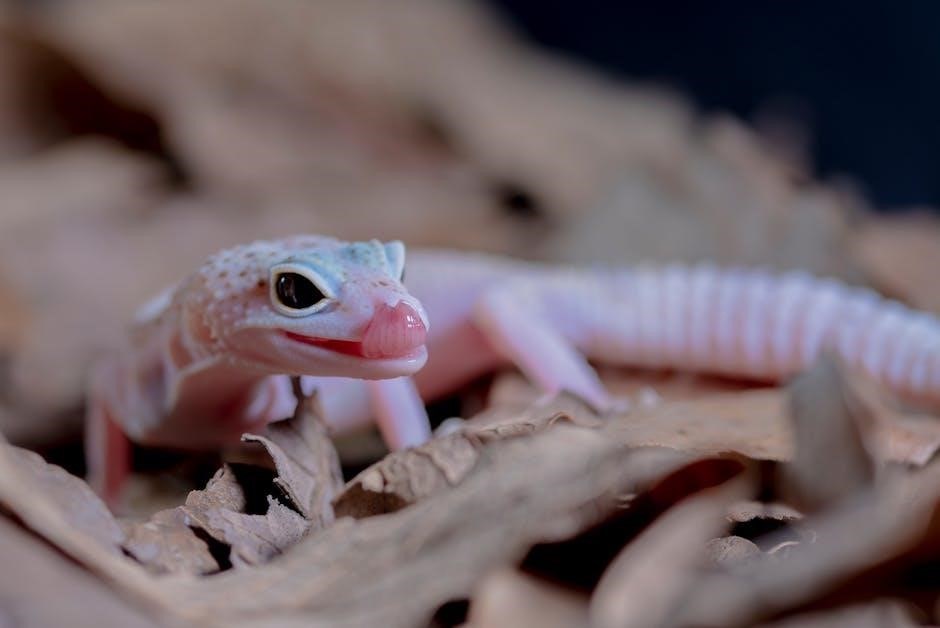Leopard geckos are popular, low-maintenance pets with a lifespan of 8-10 years. They are terrestrial, store fat in their tails, and thrive with proper care and attention.
1.1 Overview of Leopard Gecko Biology
Leopard geckos (Eublepharis macularius) are small, terrestrial lizards native to desert environments. They typically live 8-10 years, with some individuals reaching up to 20 years in captivity. Hatchlings are 3-4 inches long, while adults range from 7-10 inches, with males being larger than females. These geckos store fat in their tails, which helps them survive during food scarcity. They are crepuscular, meaning they are most active during dawn and dusk. Leopard geckos have a hardy nature, making them ideal pets, but proper care is essential to ensure their well-being. Their biology is well-suited for captivity, provided they receive the right environment, diet, and attention. Understanding their natural behaviors and physiological needs is key to successful care.
1.2 Importance of Proper Care and Housing
Proper care and housing are crucial for the health and longevity of leopard geckos. A secure, well-ventilated enclosure prevents escape and reduces bacterial buildup. Adequate space, such as a 30-40 gallon tank for adults, ensures they can move comfortably. Proper lighting, including UVB for daytime and ceramic bulbs for nighttime, maintains a healthy environment. A heat gradient is essential, with a cooler area for thermoregulation. Housing multiple adults together can lead to stress and injury, so solitary housing is recommended. A clean, safe substrate like reptile carpet or paper towels avoids respiratory issues. Regular maintenance and a balanced diet are vital for preventing health problems. By addressing these needs, owners can create a thriving environment that supports their gecko’s physical and mental well-being.

Habitat and Environment
A secure, well-ventilated enclosure with proper lighting and temperature gradients is essential. A 30-40 gallon tank is recommended for adults, providing ample space and safety.
2.1 Recommended Enclosure Size and Type
A suitable enclosure for leopard geckos should provide enough space for movement and comfort. For adult geckos, a 30-40 gallon tank (approximately 30x16x16 inches) is recommended, while juveniles can thrive in a 20-gallon long enclosure. The enclosure should be secure, with a tight-fitting lid to prevent escape. Front-opening tanks are ideal for easy access and stress-free maintenance. Proper ventilation is crucial to prevent bacterial growth, so a screen top or well-ventilated lid is necessary. A temperature gradient should be established, with a basking spot and cooler areas. Avoid loose substrates like sand; instead, use reptile carpet, paper towels, or tile for safety. Hiding places and visual barriers should be included to reduce stress. Regular cleaning is essential, so the enclosure should be easy to disinfect and maintain.
2.2 Substrate Options and Safety
Choosing the right substrate is crucial for leopard gecko safety. Safe options include reptile carpet, paper towels, or tile, as they are easy to clean and reduce the risk of impaction. Avoid loose substrates like sand, calcium sand, or wood shavings, as they can cause digestive issues if ingested. Substrate should be replaced or cleaned regularly to maintain hygiene. Paper towels are ideal for hygiene and ease of cleaning, while reptile carpet provides a natural look. Whichever substrate you choose, ensure it is non-toxic and free from loose particles. Proper substrate maintenance helps prevent health problems and ensures a clean environment for your gecko.
2.3 Temperature Gradient and Lighting Requirements
A proper temperature gradient is essential for leopard geckos. Provide a basking spot with a temperature of 85-90°F (29-32°C) during the day and a cooler area around 75-85°F (24-29°C) for thermoregulation. Use a UVB light for daylight to create a basking area and a ceramic bulb or nightlight for maintaining safe nighttime temperatures. Avoid using loose substrates near heating sources to prevent impaction. The temperature gradient allows your gecko to regulate its body temperature effectively. Maintain humidity levels appropriately and ensure all lighting is safe and securely placed to prevent burns or escape attempts. Proper lighting and temperature management are critical for your leopard gecko’s health and well-being.
Diet and Nutrition
Leopard geckos are insectivores, primarily eating live prey like crickets, mealworms, and waxworms. Feed juveniles daily and adults 3-4 times a week. Dust prey with calcium and vitamins regularly for optimal health.
3.1 Types of Prey Items and Feeding Schedule
Leopard geckos are insectivores, relying on live prey for nutrition. Common prey items include crickets, mealworms, waxworms, superworms, and Dubia roaches. Feed hatchlings daily with small prey like pinhead crickets, while juveniles and adults can be fed 3-4 times weekly. Adults typically eat larger prey items such as adult crickets or mealworms. Waxworms and superworms should be offered sparingly as treats due to their high fat content. Ensure prey is gut-loaded and dusted with calcium and vitamin D3 supplements, especially for younger geckos. A feeding schedule of 2-3 prey items per inch of the gecko’s length is recommended. Always remove uneaten prey to maintain a clean environment and prevent stress.
3.2 Supplementation and Gut Loading
Proper supplementation is crucial for a leopard gecko’s health. Dust prey items with calcium powder, especially for hatchlings and juveniles, to support bone growth. Use a multivitamin supplement once a week to ensure a balanced diet. Gut loading involves feeding prey items nutrient-rich foods 24 hours before offering them to your gecko. This maximizes the nutritional value of each meal. For adults, supplementation can be less frequent but still necessary. Always follow product instructions to avoid over-supplementation, which can harm your gecko. A well-planned supplementation routine ensures your leopard gecko receives all essential vitamins and minerals for optimal health and longevity.
3.4 Hydration and Water Bowl Placement
Hydration is essential for your leopard gecko’s health. While they obtain some moisture from their prey, a shallow water bowl should always be available. Place the bowl in the cooler area of the enclosure to encourage drinking. Use a heavy dish to prevent tipping and ensure easy access. Change the water daily to prevent bacterial growth. Additionally, misting the enclosure lightly a few times a week can help maintain humidity and support shedding. A clean, reliable water source is crucial for your gecko’s well-being, so monitor it regularly to ensure freshness and accessibility. Proper hydration practices contribute significantly to your leopard gecko’s overall health and longevity.

Health and Wellness
Leopard geckos are generally hardy, but regular monitoring is crucial. Look for clear eyes, active behavior, and a well-rounded body. Signs of illness include lethargy or skin issues. Early detection of common ailments like metabolic bone disease or respiratory infections is key for effective treatment. A balanced diet, proper environment, and stress-free conditions promote overall wellness. Regular veterinary check-ups and a clean habitat help prevent health problems, ensuring your gecko leads a long, thriving life. Proper care practices are vital for maintaining their health and addressing any potential issues promptly and effectively.
4.1 Signs of a Healthy Leopard Gecko

A healthy leopard gecko exhibits clear, bright eyes, active movements, and a robust, well-rounded body. The gecko should have a plump tail, indicating good fat reserves, and smooth, shedding-free skin. It should be free from visible injuries, sores, or discoloration. Healthy geckos are alert and responsive, showing curiosity or activity during their natural crepuscular periods. Their bellies should not drag, and they should maintain good posture while moving. Regular shedding without retained skin is another sign of health. A gecko that eats willingly, maintains a steady weight, and shows no signs of lethargy or stress is thriving. These physical and behavioral traits are key indicators of a gecko’s overall wellness and proper care.
4.2 Common Health Issues and Prevention
Leopard geckos are generally hardy, but common health issues include metabolic bone disease (MBD), respiratory infections, and skin or tail rot. MBD is caused by inadequate calcium and UVB lighting, leading to weakened bones and muscle tremors. Respiratory issues arise from poor ventilation or excessive humidity, often manifesting as labored breathing or lethargy. Skin and tail rot can develop due to high humidity or injuries. Prevention involves providing a well-ventilated, properly lit enclosure with a balanced diet rich in calcium and vitamin D3. Regularly monitoring humidity levels, ensuring a clean environment, and avoiding overcrowding can significantly reduce the risk of these issues. Early detection and veterinary care are crucial for treating these conditions effectively.

Handling and Behavior
Leopard geckos are calm and tolerate handling well. They are nocturnal, so activity peaks at night. Handle gently, avoiding sudden movements, to ensure a stress-free experience.
5.1 Tips for Safe and Stress-Free Handling
Handle leopard geckos gently and briefly, especially for young or new pets. Start with short sessions (5-10 minutes) to avoid stress. Ensure the gecko is warm and active, as cold geckos may be more nervous. Support the body and tail to prevent drops. Avoid handling after feeding or shedding, as this can cause discomfort. Wash hands before and after handling to maintain hygiene. Never pick up a gecko by the tail, as this can cause injury. If the gecko struggles or shows signs of stress (e.g., darkening color or attempting to bite), return it to its enclosure immediately. Patience and gentle interaction will help build trust and make handling enjoyable for both you and your pet.
5.2 Understanding Leopard Gecko Behavior
Leopard geckos are primarily nocturnal, meaning they are most active at night, but they also exhibit crepuscular behavior, showing activity during dawn and dusk. They are naturally curious and often explore their environment, making them engaging pets. In captivity, they may display behaviors like hunting for prey or climbing, which are essential for their well-being. Leopard geckos are generally solitary animals and prefer to live alone, as cohabitation can lead to stress or injury. They are known for their calm demeanor and can tolerate handling well when accustomed to it. Observing their behavior, such as bright eyes, active movement, and a robust posture, is key to ensuring their health and happiness. Understanding these traits helps owners provide a suitable environment and care routine tailored to their needs.
Genetics and Morphs
Leopard geckos exhibit diverse morphs, including albino, tremper, and snow, influenced by recessive, dominant, and polygenic traits. These genetic variations create unique color and pattern combinations.
6.1 Overview of Leopard Gecko Morphs
Leopard geckos display a wide variety of morphs, each characterized by unique color patterns and traits. Common morphs include albino, tremper, snow, and blizzard, among others. These morphs result from genetic variations, such as recessive or dominant traits, and can significantly alter the gecko’s appearance. For instance, albino morphs lack pigmentation, while snow morphs exhibit a pale, almost white coloration. Morphs like the tremper albino combine striking patterns with vibrant hues. The diversity of leopard gecko morphs has made them highly popular in the pet trade, with breeders continually discovering new and exciting variations. This genetic diversity not only adds to their appeal but also allows owners to choose a morph that suits their preferences. Understanding morphs is essential for enthusiasts looking to appreciate or breed these fascinating creatures.
6.2 Genetic Traits and Breeding Basics
Leopard geckos exhibit a range of genetic traits that influence their appearance and breeding potential. These traits can be recessive, dominant, co-dominant, or polygenic, resulting in diverse morphs. Breeding involves understanding these genetic principles to predict offspring characteristics. For example, breeding an albino gecko (recessive trait) with a non-albino can produce offspring with varying traits. Proper breeding practices include selecting healthy adults, providing optimal conditions, and ensuring genetic diversity. It’s crucial to research and understand the genetic makeup of breeding stock to achieve desired morphs and avoid unintended outcomes. Responsible breeding enhances the hobby and ensures healthy, unique geckos for enthusiasts. This process requires patience, knowledge, and a commitment to ethical practices to preserve the species’ genetic integrity.
